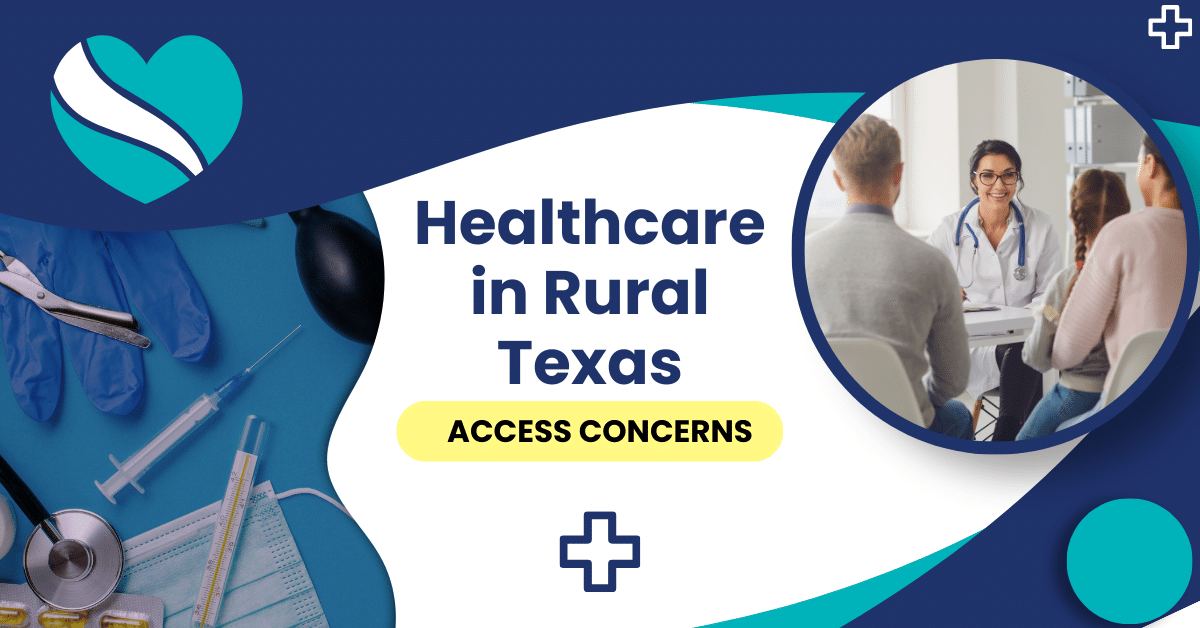Share the post "Should You Be Concerned About Healthcare Access in Rural Texas? Prepare For Our Future"
We must acknowledge the complex interaction of socioeconomic circumstances, governmental decisions, and geographic barriers that affect rural Texas healthcare access and quality. Increasing hospital closures and healthcare deserts across the state’s vast rural territory heighten our concerns. Rural Texans’ health, well-being, and economic stability are threatened by this healthcare shortage.
Despite the obstacles, technology advances and community-driven initiatives are closing the healthcare gap. Rural underprivileged communities are seeing promise from dedicated healthcare professionals and innovative telemedicine programs. Staying informed and involved as we examine rural healthcare in Texas is crucial because our choices now will affect the future accessibility and effectiveness of healthcare for all Texans outside the urban core.
Key Takeaways
- Hospital closures and geography hinder rural Texas healthcare access.
- Rural healthcare improvement requires technology and community engagement.
- Rural Texas communities need informed action for future health.

Rural Healthcare Landscape in Texas
As we explore the healthcare landscape in rural Texas, it’s crucial to recognize the challenges faced by community hospitals, the availability of primary care, and the growing importance of telehealth solutions.
Current Condition of Rural Hospitals
Many of our rural hospitals are in a state of distress; facilities have been closing at an alarming rate due to financial instability. From 2010 to 2020, there were 26 hospitals that closed in 22 communities. This trend is deeply concerning as it means a loss of immediate healthcare for our rural inhabitants, including emergency services.
Access to Primary Care Services
In terms of primary care, rural Texans are finding themselves at a disadvantage compared to their urban counterparts. There is a shortage of primary care physicians, and as per The Texas Observer map, this shortage is expected to grow. This directly impacts our community by limiting access to essential healthcare services and contributes to health disparities between rural and urban populations.
Telehealth as a Solution
To counteract some of the challenges, telehealth has emerged as a promising solution. It embodies the potential to extend healthcare services to remote areas, thus improving access. Legislation such as SB 1246, which was designed to enhance the rural health care delivery system in Texas and is mentioned in the Rural Community Health System report, supports the deployment of telehealth services, which can bridge the gap for many Texans living in rural areas.

Challenges Faced by Rural Texans
In rural Texas, we’re witnessing a healthcare conundrum that impacts our communities deeply. Not only do we grapple with a scarcity of medical professionals, but also the miles that separate patients from care and the financial hurdles are daunting.
Healthcare Professional Shortages
In our rural landscapes, we encounter a stark reality: a critical shortage of healthcare professionals. It’s disheartening to discover that over 25 counties lack even a single primary care physician, as confirmed by TAMIU Online. As we strive for wellness, this deficit challenges our ability to promptly and adequately address healthcare needs.
Transportation and Distance Barriers
The vast distances in rural Texas contribute to our healthcare strife. For many of us, clinics and hospitals are more than just a quick drive away, and reliable transport becomes a precious commodity. This journey to care is not just about distance but also the time and means that many of our community members struggle to find.
Economic and Insurance Constraints
We’re also facing economic and insurance constraints that test our resilience. With higher rates of uninsured individuals and lower incomes, accessing quality healthcare isn’t just a challenge – it’s a financial strain that can deter us from seeking necessary treatment. The dialogue around these economic barriers is one we must continue in earnest if we’re to find sustainable solutions.

Impact of Policy on Rural Healthcare
In rural Texas, healthcare availability hinges on policies that shape access, quality, and sustainability of medical services. We’ll look into how government programs, funding initiatives, and regulatory changes directly influence the healthcare landscape in these areas.
Government Healthcare Programs
Medicare and Medicaid: We’ve observed that these two programs are vital for many rural Texans. With a significant portion of rural residents being older or having lower incomes, Medicare and Medicaid provide a safety net. It’s crucial that policy enhancements cater to increasing provider participation and ensuring these programs adapt to meet the specific needs of rural populations.
State and Federal Funding Initiatives
Grants and Subsidies: We’re encouraged by various funding sources aimed at supporting rural healthcare infrastructure. For example, the Texas State Office of Rural Health offers programs like the Rural Hospital Flexibility Program, providing critical access hospitals with financial assistance. However, continuity and expansion of such initiatives are essential to address the growing healthcare demands.
Regulatory Changes and Implications
Regulatory Hurdles and Telehealth: Regulations often have unintended consequences in rural settings. For instance, the expansion of telehealth services in rural areas faced initial regulatory barriers. Nevertheless, recent policy shifts during the pandemic have shown that regulatory flexibility can foster innovation that improves access to healthcare for our rural communities. We must advocate for policies that permanently integrate telehealth advancements into rural healthcare delivery.

Technological Advancements in Rural Healthcare
We’re witnessing an exciting era of innovation that’s transforming rural healthcare. These advancements aim to bridge the gap in healthcare accessibility and quality between rural and urban areas.
Innovations in Remote Patient Monitoring
We’ve seen an impressive growth in remote patient monitoring technologies, which allow healthcare providers to track a patient’s health in real-time, significantly expanding the reach of rural healthcare. This technology enables us to monitor vital signs, manage chronic conditions, and maintain a close connection with patients who may live miles away from the nearest clinic. Tools like wearable devices are not only convenient but are becoming increasingly sophisticated, empowering patients and doctors alike with actionable health data.
Electronic Health Records Expansion
The expansion of Electronic Health Records (EHRs) has been a game-changer for us. Having a secure, digital version of a patient’s medical history allows seamless information sharing among clinicians. This continuity of care ensures that, no matter where a patient is seen, their health information is up to date and accurate. It streamlines the diagnosis and treatment process and can save lives in emergencies, especially in isolated rural regions.
Mobile Health Clinics and Outreach
Lastly, we must talk about mobile health clinics. These clinics on wheels bring healthcare services directly to communities, significantly improving access for us in areas that are underserved. They often provide screenings, vaccinations, and other basic services, dramatically reducing the distance that our rural patients must travel. Additionally, our health outreach initiatives focus on education and prevention, keeping communities informed and engaged in proactive health management.

Community Involvement and Education
We’re energized to see how community involvement and education directly influence the availability of healthcare in rural Texas. Our collaborative efforts in raising health awareness, fostering academic partnerships, and building support networks are impeccable.
Local Health Awareness Campaigns
We actively initiate local health awareness campaigns to enlighten rural residents about available healthcare services. Through these campaigns, we distribute accurate health information and promote preventive care measures which are essential for improving overall community wellness.
- Topics Covered:
- Vaccination schedules
- Nutritional guidance
- Disease prevention techniques
- Information on local health resources
Partnership with Educational Institutions
We’ve forged strong partnerships with local schools and universities to incorporate healthcare education into their curriculums. This collaboration ensures that the next generation of rural Texans understands the significance of healthcare from an early age.
- Benefits:
- Students receive hands-on health education.
- Potential to inspire future healthcare professionals.
- Creation of a well-informed community.
Grassroots Advocacy and Support Networks
We’re passionate about developing grassroots advocacy groups and support networks that empower residents to take charge of their health. Together, we champion for better healthcare policies and ensure that no one in our community is left without access to the care they need.
- Approaches:
- Community meetings
- Health policy workshops
- Support for healthcare access legislation

Future Outlook for Rural Texans
As we look ahead, the landscape of healthcare in rural Texas is poised for noteworthy changes. Here’s our dive into what these changes entail for rural communities.
Projected Healthcare Trends
- Digital Health Integration: We anticipate a surge in telemedicine, diminishing the distance barrier in rural areas. This shift could significantly improve access to specialists and reduce unnecessary hospital visits.
- Aging Population: We’re preparing for the growing elderly demographic in rural Texas, which will amplify the demand for healthcare services, particularly in-home care and chronic disease management.
Potential Investments and Expansions
- Infrastructure Improvements: We expect that; state and private funding will lead to improved healthcare infrastructure, including the expansion of rural hospitals and clinics.
- Broadband Expansion: We’re optimistic that the statewide push for broadband internet access will facilitate more telehealth services and health information technology advancements, bolstering healthcare delivery in our rural communities.
Long-Term Solutions for Sustained Care
- Education and Training Programs: We foresee an emphasis on education with initiatives aimed at increasing the number of healthcare professionals in rural areas.
- Policy Support: We predict favorable policies from the government designed to incentivize physicians to practice in underserved areas, ensuring long-term healthcare sustainability for rural Texas.
Share the post "Should You Be Concerned About Healthcare Access in Rural Texas? Prepare For Our Future"
Christian Linden is a seasoned writer and contributor at Texas View, specializing in topics that resonate with the Texan community. With over a decade of experience in journalism, Christian brings a wealth of knowledge in local politics, culture, and lifestyle. He holds a Bachelor's degree in Communications from the University of Texas. When he's not writing, Christian enjoys spending weekends traveling across Texas with his family, exploring everything from bustling cities to serene landscapes.











